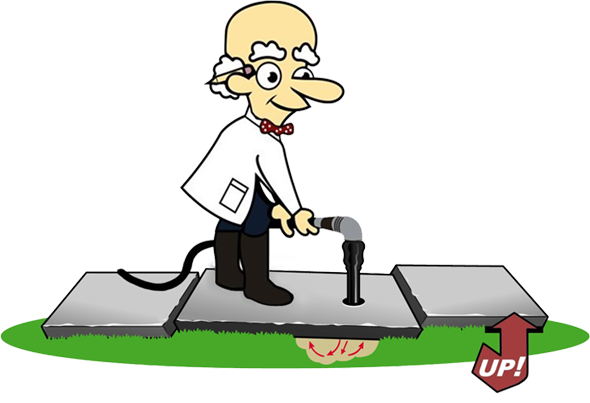Concrete Chiropractor Video Gallery
Welcome to the Concrete Chiropractor video gallery and information center. In the videos below you can see more information about topics we get asked about all the time. We hope you find these videos useful!
Concrete Leveling and Raising Company Serving New Jersey and Eastern Pennsylvania
Check out our new promotional video. Concrete Chiropractor is a 5 star rated concrete leveling and concrete raising company serving the residential and commercial industries for over 2 decades.
Concrete Settlement Cause
The main cause of concrete settlement is consolidation of loosely backfilled subsoils during initial construction. As time and moisture remove air space between the soil granules, consolidation takes place, causing the soils to settle and concrete or any other construction placed on these soils to settle along with it.
Concrete leveling or mudjacking is a process used to raise and correct these issues without he need for costly replacement.
Concrete leveling and Mudjacking. Lack of soil back fill and compaction
This video shows how improper backfill and soil compaction or the lack of it can affect the long-term stability of concrete repair or replacement on the surface.
Backfill of soil around homes that lead to concrete settlement or sinking concrete slabs should be addressed during initial construction through a process known as mechanical compaction. The soil is placed in layers of not more than one foot. Each layer is mechanically compacted with the use of motorized plate compaction equipment. This will prevent or minimize the amount of soil consolidation that will take place. However, even with these steps being taken, concrete settlement can still occur for a period of years based on soil composition, moisture, and time.
Mudjacking or Poly Foam for Concrete Leveling. Which is better?
As you search the web regarding the correction of settled or sinking concrete, you may come across claims related to the use of poly foam as a product to raise concrete.
One claim that has been made related to poly foam is that it will expand to compact existing base soils. In this video, you can see that the root cause of soil settlement can be several feet deep in the ground. Compaction of these base soils at that depth is often skipped, leading to concrete settlement failure.
While raising your concrete regardless of product may correct the settlement issue on the surface, this video will show that any claim that a concrete raising product will correct the soil settlement issue at full depth is a gross misrepresentation!
Poly Foam Expansion and Soil Compaction
Claims have been made that poly leveling foam will not wash out from under concrete.
While this is true and a quality cement grout that is five times the strength of poly foam will serve the same purpose, let’s address the real concern.
In this video, we show you the “true” concern when it comes to wash out. An excessive amount of poorly drained water will lead to ongoing washout and settlement of the base soils regardless of product used to raise your concrete. ALL water issues must be corrected to prevent future settlement and base failure, as any method of correction including concrete replacement will fail if the water issue remains.
Some Happy Customers Sharing Their Thoughts
In this video you’ll see several happy customers sharing their thoughts on our Concrete Leveling and Concrete Raising Services.
How Strong is Our Concrete Raising Grout?
We had our pumping material strength tested by the New Jersey Institute of Technology. We think you’ll be impressed with the results. Check it out!
Mudjacking Versus Poly Level Foam Concrete Raising (Poly Leveling)
This video explains the differences between mudjacking and poly level foam concrete raising. Mudjacking is far superior, eco-friendly and non toxic.
Sealing Waterproofing Cracks in Concrete
How to Repair, Seal and Waterproof Cracks in Concrete: This video shows you how to repair cracks in concrete floors by sealing and waterproofing the damaged areas of your concrete surface with QUIKRETE® Polyurethane Concrete Crack Sealant.
Repairing Sealing Horizontal Joints
This how-to video shows you how to repair and seal vertical and horizontal expansion joints.
Repairing Sealing Cracks
How to Repair Concrete Cracks: This video shows you how to fill, repair, and seal cracks in concrete, using QUIKRETE® Concrete Crack Seal.
Resurfacing Concrete Slabs
This video shows you how to resurface, restore, repair, renew and refinish your worn concrete surfaces with QUIKRETE® Concrete Resurfacer, using a brush, trowel or squeegee and Concrete Resurfacer.


